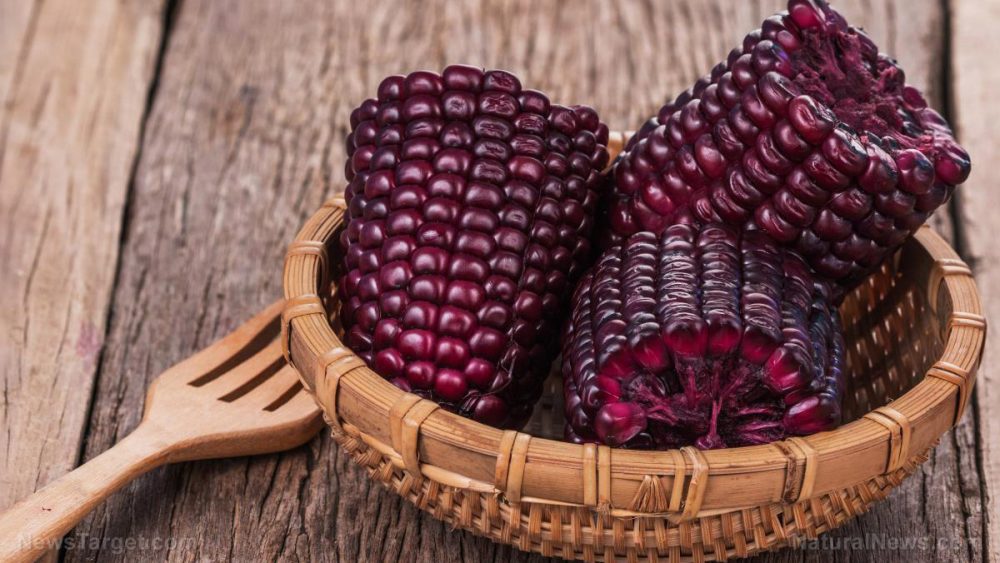
Advertisement
When it comes to superfoods, corn may be the last thing most people think of. After all, it is one of the most genetically modified crops in the States. But locally grown, organic corn does have nutritional benefits, and researchers from the University of Illinois developed new kinds of purple corn (Zea mays L.) to study how different combinations of phenolic compounds may impact their anti-inflammatory, anti-obesity, and anti-diabetic potential. Their findings appeared in the journal Food Chemistry.
Phenolic compounds that give purple corn its hue have anti-obesity and anti-diabetes potential
Corn kernels have an outer layer called a pericarp, which is the part that shows their different colors. This part also houses the phenolic compounds that give maize their nutritional benefits. For the current study, the researchers used a strain of maize called Apache Red to develop 20 varieties of purple corn, each with its own unique combination of anthocyanins, a class of phenols responsible for the color of purple corn. According to research, anthocyanins can reduce the risk of cardiovascular disease, Type 2 diabetes, and certain cancers.
The researchers extracted anthocyanins from the pericarp of different varieties of purple corn kernels using pressurized water. They then freeze-dried the aqueous extracts containing anthocyanins prior to analysis. The researchers found that the pericarp contained high amounts of anthocyanins and other phenolic compounds, with concentrations varying significantly among the different varieties of corn.
The researchers proceeded to investigate the effects of anthocyanin-rich extracts on obesity-induced inflammation. Using mice, they combined fat cells called adipocytes with large immune cells called macrophages to simulate the cells of obese people with high concentrations of lipids and inflammation. They also examined models that simulated the cells of healthy people who regularly consumed plant-based foods rich in polyphenols.
Focusing on specific biomarkers related to inflammation and adipogenesis, the researchers observed that the phenols in the extracts altered the development of adipocytes, reducing their fat content by eight to 56 percent, depending on the phenols used.
Next, the researchers analyzed the impact of the anthocyanin-rich extracts on insulin resistance. To induce insulin resistance, they used a cell-signaling protein in the mouse fat cells, then treated the cells with anthocyanins and monitored glucose uptake. The researchers found that, depending on phenol content, the extracts decreased a key marker of insulin resistance by 29 to 64 percent. They also decreased glucose uptake by 30 to 139 percent.
“We observed very important changes in molecules that reduced oxidative stress and inflammation in the insulin-resistant adipocytes,” said postdoctoral researcher and study co-author Diego Luna-Vital. “We also found important changes in pro-inflammatory molecules in the immune cells.”
Based on their findings, the researchers concluded that the different levels and compositions of anthocyanin compounds have an impact on biomarkers for obesity, inflammation, and Type 2 diabetes. They added that smaller phenolic compounds like quercetin, luteolin and rutin that are also present in the extracts played key roles in reducing some of the said markers.
Food science professor and study lead Elvira Gonzalez de Mejia noted that the beneficial effects of purple corn extracts resulted from the synergistic mechanism of the combined phenols, rather than just one or two individual compounds.
Purple vs. yellow
Besides the potential health benefits, the researchers believe that the pericarp of brightly colored maize like purple corn can be used as natural sources of food colorants, giving these kinds of corn added value as a staple crop.
“We calculated that all of the red dye No. 40 — one of the major dyes used in the U.S. — could be replaced with the pigment derived from about 600,000 acres of corn,” said crop sciences professor and study co-author John Juvik. “And we could produce the anthocyanin-rich pericarp in sufficient quantities for manufacturers to add it to beverages or special products with pharmaceutical properties.”
Corn comes in many colors: blue, purple, red, and even white. Different types of corn have varying levels of nutritional benefits.
Purple corn, also known as Hopi maize because it was a staple of the Hopi Native Americans, can be found in present-day Arizona, New Mexico, and Colorado. It is also cultivated throughout South America in Peru, Bolivia, Ecuador, and Argentina.
The South American varieties are darker in color than their North American counterparts. The darker the variant, the more antioxidants it contains. In fact, raw purple corn has nearly 14 times more antioxidants than yellow.
These types of corn are not at all genetically modified to have unconventional colors – their hues come naturally because of the polyphenols they contain, particularly anthocyanins. These are the same natural compounds responsible for the vibrant hues of blueberries and raspberries.
Sources include:
Advertisements







